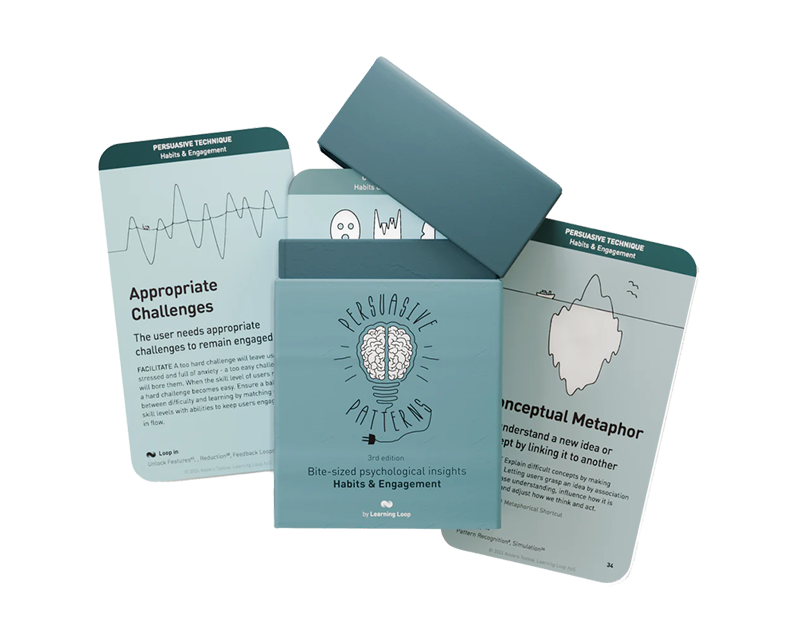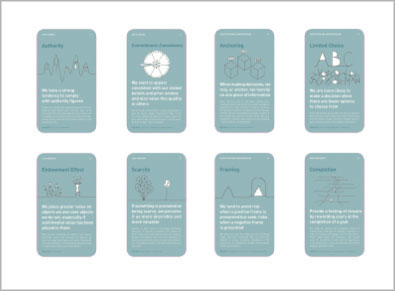Persuasive Patterns: Facilitation
Feedback Loops
We are influenced by information that provides clarity on our actions
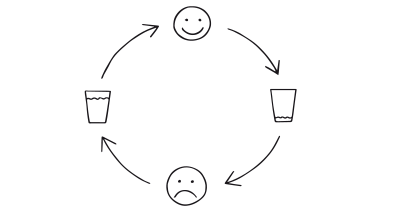
Feedback Loops refer to the process where the outputs of a system are circled back and used as inputs, providing users with real-time information about their actions to reinforce or modify their behavior.
Imagine you’re trying to improve your fitness. You buy a smartwatch that tracks your daily steps, heart rate, and calories burned. Each evening, you review your activity data. On days you notice your step count is low, you feel motivated to walk more the next day. This simple feedback loop – tracking your activity and reflecting on it – subtly influences your behavior, encouraging you to be more active.
Now, consider a language learning app. As you complete lessons, the app provides instant feedback on your performance, highlighting areas of strength and those needing improvement. This feedback loop is similar to your fitness tracker. It helps you understand your progress and guides you to focus on specific areas, enhancing your learning experience. The app’s design, using feedback loops, mirrors the way you used your fitness tracker to improve your fitness, applying the same principle to language learning.
The study
One of the seminal studies in the realm of Feedback Loops was conducted by Bandura and Cervone in 1983, focusing on self-evaluation and the regulation of behavior. The researchers specifically investigated how feedback about personal performance influenced individuals’ behavior in goal-directed tasks. The study involved participants performing a task, with some receiving feedback about their progress towards achieving a set goal.
Participants who received progress feedback showed a significant increase in their effort and persistence compared to those who did not receive such feedback. Specifically, the group with feedback increased their effort by approximately 30% more than the control group. The study also found that feedback led to a 25% improvement in the accuracy of task performance.
Participants who received feedback were 40% more likely to achieve their set goals than those who did not. Feedback also influenced the setting of future goals, with recipients of positive feedback setting goals that were on average 15% higher than their previous ones.
Bandura, A., & Cervone, D. (1983). Self-evaluative and self-efficacy mechanisms governing the motivational effects of goal systems. Journal of Personality and Social Psychology, 45(5), 1017-1028.
Feedback Loops play a critical role in shaping user behavior and decision-making. By providing immediate information on the consequences of their actions, users can better understand the impact of their choices, leading to improved engagement, learning, and adaptation. This pattern is fundamental in creating interactive and responsive systems that encourage positive behavior and enhance user experience.
The psychological principle underlying feedback loops is deeply rooted in our cognitive and behavioral responses to information about our actions. This principle is largely influenced by the concepts of self-regulation, reinforcement, and motivation.
- Self-regulation
Feedback loops are integral to self-regulation, a process where individuals control their behavior, emotions, and thoughts towards achieving long-term goals. Self-regulation theories, like Bandura’s Social Cognitive Theory, emphasize the role of feedback in self-assessment and adjustment of actions. Feedback provides individuals with information about their progress, which they use to regulate subsequent behavior. For example, if feedback indicates that one is far from a goal, one might increase effort or change strategies. - Reinforcement and operant conditioning
Feedback loops also draw on principles of reinforcement from operant conditioning, a theory developed by B.F. Skinner. In this context, feedback acts as a form of reinforcement that can either encourage or discourage certain behaviors. Positive feedback reinforces and increases the likelihood of a behavior being repeated, while negative feedback can decrease its occurrence. - Motivation and goal-setting
Feedback affects motivation through goal-setting and achievement. The Goal-Setting Theory by Locke and Latham suggests that specific and challenging goals along with appropriate feedback enhance motivation and performance. Feedback helps in clarifying the goal, understanding the gap between current and desired performance, and fostering a sense of achievement upon progress.
Feedback loops also align with information processing theories in psychology. They provide critical information that individuals process and use to modify their cognition and behavior. This processing can be conscious or unconscious, immediate or delayed, but it is essential for learning and adaptation.
From a behavioral economics perspective, feedback loops can be seen as tools that help individuals overcome cognitive biases and make better decisions. By providing timely and relevant information, feedback can correct misconceptions and lead to more rational decision-making.
Designing products through Feedback Loops
Designers can create systems that provide meaningful, timely, and constructive feedback, helping users understand the impact of their actions, learn from their experiences, and feel more engaged and motivated to continue interacting with the product or service.
There are two primary types of Feedback Loops: positive and negative. Each plays a crucial role in balancing a system, influencing user behavior and experience.
Positive Feedback Loops
Positive feedback loops amplify outcomes, driving change within the system. They are instrumental in reinforcing desirable behaviors. For example, in a fitness tracking app, a positive loop could involve rewarding users with badges for consistently meeting their daily step goals. This reinforcement encourages continued engagement and habit formation.
However, if left unchecked, positive feedback can lead to negative consequences. It’s important to moderate these loops to prevent them from spiraling out of control. For instance, in a social media platform, too much emphasis on ‘likes’ and ‘shares’ as positive feedback can lead to addictive behaviors and anxiety.
Negative Feedback Loops
Negative feedback loops serve to stabilize a system. They act as a counterbalance to positive feedback, ensuring the system remains around an equilibrium point. In an educational app, if a user performs poorly on a quiz, a negative feedback loop might involve suggesting remedial content or additional practice exercises. This helps the user to improve and prevents frustration.
While negative feedback is crucial for stability, excessive negative feedback can hinder growth and innovation. It’s important to strike a balance so that users are not discouraged or demotivated.
Systemic perspective
When designing feedback loops, consider how changes in one part of the system affect others. This holistic view ensures a well-rounded user experience. For example, in an e-commerce website, altering the feedback mechanism for product reviews will not only influence buyer behavior but also seller actions and overall platform trustworthiness.
Employ positive feedback loops to drive growth and change, but simultaneously integrate negative loops to maintain stability and prevent runaway behaviors. Still, be cautious of creating too strong a negative feedback loop, as it can lead to system stagnation and user disengagement.
Crafting effective Feedback Loops
Feedback loops are essential in product design, providing users with insights that influence their actions and decisions. To create effective loops, focus on optimizing their speed, measurability, context, and connection to motivations.
- Speed is critical
The longer it takes for feedback to arrive, the less impact it has on future decisions. In digital products, this immediacy can be achieved through real-time simulations or quick responses to user actions. For example, financial websites can simulate investment outcomes, giving users a tangible sense of future rewards. Incorporating instant feedback, like push notifications for social interactions, also reinforces the user’s actions and encourages continued engagement. - Quantifiable feedback is easier to understand and act upon
Like nutrition labels that make food choices clearer, digital products should offer measurable feedback. This could be through visual comparisons or clear metrics that help users easily gauge their progress or performance. However, ensure that these metrics accurately reflect the user’s reality and are grounded in meaningful data. - Frame feedback in a context
Feedback should be framed within the larger context of the user’s goals. For instance, instead of merely indicating how much money a user has spent, relate it to their budgeting goals. This contextual feedback helps users understand how their actions align with their objectives, making the feedback more relevant and actionable. - Feedback must resonate with the user’s motivations
While gamified elements like points and badges can be engaging, they should tie back to meaningful rewards or goals. Understand what drives your users – whether it’s health, wealth, relationships, or personal growth – and tailor the feedback to these aspirations. This alignment ensures that the feedback loops are not only engaging but also sustainably influential. - Tailor the feedback to individual users
Personalized feedback is more likely to be relevant and acted upon. An e-learning platform can adapt its feedback based on the learner’s pace and style, offering more detailed explanations where needed. - Visual is better
Utilize visual aids like graphs, progress bars, or color-coded alerts. Visual feedback is more engaging and easier to interpret. A budgeting app, for example, could use graphs to show spending trends over time. - Relevance is king
Make sure the feedback provided is relevant to the user’s goals and offers clear next steps or adjustments. For instance, a project management tool could provide suggestions for improving time management based on the user’s task completion history. - Constructive feedback changes behavior
While positive reinforcement is motivating, constructive criticism is essential for growth. Balance both in your feedback. A language learning app, for instance, should celebrate achievements while also pointing out areas for improvement. Feedback that prompts users to reflect on their actions and outcomes deepens understanding and promotes self-regulated learning. A meditation app could ask users to reflect on their mental state before and after a session.
Too much feedback can be overwhelming and counterproductive. Limit feedback to key actions and avoid bombarding users with too much information. Effective feedback loops create a continuous dialogue between the user and the product, guiding and informing their journey every step of the way.
Ethical recommendations
The misuse of Feedback Loops can have significant ethical implications, particularly when they lead to addictive behaviors or manipulate user decisions. This misuse is not just theoretical but has been observed in real-world applications, raising serious ethical concerns.
For instance, social media platforms and certain digital games use feedback loops (like likes, shares, notifications, progress bars, and levels) to create highly engaging experiences. While engagement itself is not negative, these platforms can foster addictive behaviors, where users feel compelled to constantly check for updates or progress in a game. This can lead to a detrimental impact on mental health, social relationships, and overall well-being.
Some games effectively use progress bars, goals, levels, and social pressures to monetize their product. However, these feedback loops are often criticized for prioritizing business goals over user well-being. They arguably exploit user emotions and desires for progress and social recognition, leading to excessive time and money spend on the games, often at the expense of the user’s creativity and real-world social interactions.
This raises important ethical questions for designers and developers: Are we creating a health improvement app, a utility, or a digital equivalent of a slot machine? What are the long-term impacts of our design on users? Products that manipulate user behavior for profit, without considering their well-being, can be both financially successful and socially harmful.
To navigate these ethical challenges, it is crucial for teams to engage in continuous ethical evaluation throughout the design process. This involves:
- Reflect on your intentions
Assess whether the product is designed to genuinely benefit users or primarily to exploit their behaviors for profit. Feedback should be designed to genuinely benefit the user, not just to increase engagement or profits. This means prioritizing features that enhance the user experience, such as educational feedback or progress tracking, over those that solely drive usage. - Avoid overstimulation
Be cautious of overloading users with constant feedback, which can lead to information overload or stress. Balancing feedback frequency to keep users informed without overwhelming them is key. - Promote positive user outcomes
Use feedback loops to encourage beneficial behaviors, such as healthy habits or learning, rather than purely addictive engagement. - Providing opt-out options
Users should have the freedom to opt out of feedback mechanisms, giving them control over their interaction with the product.
Real life Feedback Loops examples
Tesla
Their real-time feedback on driving performance and energy consumption taps into the psychological effect of immediate reinforcement. Drivers see the impact of their driving habits on energy efficiency, prompting them to adjust their behaviors for optimal performance and resource conservation.
Mint
The Mint budgeting app offers financial feedback that influences users’ spending habits. This feedback mechanism employs the psychological principle of reinforcement learning. By setting budget goals and tracking spending against these targets, users are constantly learning and adjusting their financial behaviors based on the app’s feedback.
Duolingo
Duolingo leverages the psychological effect of immediate correction in language learning. As users complete exercises and quizzes, they receive instant feedback, which is crucial for learning and memory. This immediate response helps users quickly identify and correct mistakes, facilitating faster and more efficient language acquisition.
Trigger Questions
- Are we providing immediate feedback to user actions?
- Is our feedback relevant and aligned with the user's goals?
- Have we balanced the amount of positive and negative feedback?
- Does our feedback encourage further engagement and learning?
- Are we providing feedback that empowers, rather than overwhelms, our users?
- How can we make our feedback loops more intuitive and less intrusive?
- In what ways can our feedback encourage positive behavior change?
- How do we measure the effectiveness of our feedback loops?
Pairings
Feedback Loops + Simulation
Combining feedback loops with simulation allows users to learn from direct experience. In a simulated environment, users receive immediate feedback on their actions, enhancing learning and adaptation. This approach is grounded in the principle of experiential learning, where experience is the source of learning and development.

We are influenced by information that provides clarity on our actions

Give people first-hand insight into how inputs affect an output
Feedback Loops +
Self-Monitoring
This pairing leverages the principle of self-regulation. By enabling users to monitor their own behavior and receive feedback, they can better regulate and adjust their actions towards desired goals. This is particularly effective in habit-forming or behavior change apps.

We are influenced by information that provides clarity on our actions
Feedback Loops + Kairos
Integrating feedback loops with the concept of Kairos – the right or opportune moment – ensures that feedback is given at the most impactful time. This strategic timing of feedback can significantly influence decision-making and behavior.

We are influenced by information that provides clarity on our actions

Communicate to users in situations that are the opportune moments for change
Feedback Loops + Triggers
Triggers prompt specific behaviors, and when combined with feedback loops, they can reinforce desired actions. This pairing is based on the principle of cue-induced behavior, where external cues trigger specific responses, and feedback reinforces them.

We are influenced by information that provides clarity on our actions

Place cues on our regular paths to remind and motivate us to take action
Feedback Loops + Goal-Gradient Effect
The closer we get to achieving a goal, the more motivated we become. By showing progress through feedback loops, users are motivated to continue as they perceive themselves getting closer to their goal.

We are influenced by information that provides clarity on our actions

Our motivation increases as we move closer to a goal
Feedback Loops + Levels
This combination uses the principle of progressive achievement. As users advance through levels, they receive feedback, which motivates continued engagement and a sense of accomplishment.

We are influenced by information that provides clarity on our actions

Use levels to communicate progress and gauge users' personal development
Feedback Loops + Self-Expression
Allowing users to express themselves and receive feedback on their expressions supports identity formation and personalization. This approach taps into the psychological need for self-expression and identity.

We are influenced by information that provides clarity on our actions

We seek opportunities to express our personality, feelings, or ideas
Feedback Loops + Delighters
Delighters are unexpected features that provide positive feedback, enhancing user satisfaction and engagement. This pairing plays on the element of surprise and pleasure in receiving unexpected positive feedback.

We are influenced by information that provides clarity on our actions
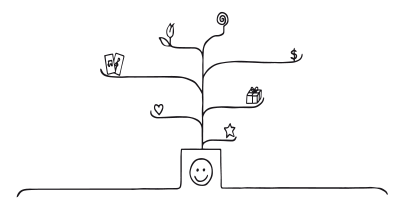
We remember and respond favorably to new, unexpected, and playful pleasures
Feedback Loops + Delay Discounting
Delay discounting involves the preference for smaller immediate rewards over larger delayed ones. Feedback loops that provide immediate, positive feedback can counteract the tendency to undervalue future benefits.

We are influenced by information that provides clarity on our actions

We tend to choose smaller immediate rewards over larger, later rewards
Feedback Loops + Choice Closure
This pairing helps users feel a sense of closure after making a decision. By providing feedback after a choice, it reinforces the decision made, reducing doubt and increasing satisfaction.

We are influenced by information that provides clarity on our actions
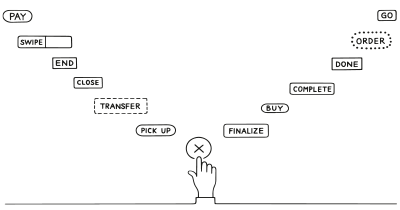
We are more satisfied with decisions when we engage in physical acts of closure
Feedback Loops + Shaping
Shaping involves gradually modifying behavior through reinforcement. Feedback loops can be used to reinforce incremental steps towards a desired behavior, effectively shaping user actions over time.

We are influenced by information that provides clarity on our actions

Successively reinforce approximations to a target behavior
A brainstorming tool packed with tactics from psychology that will help you build lasting habits, facilitate behavioral commitment, build lasting habits, and understand the human mind. It is presented in a manner easily referenced and used as a brainstorming tool.
Get your deck!- Industrial dynamics by Forrester
- On the self-regulation of behavior by Carver & Scheier
- Bandura, A., & Cervone, D. (1983). Self-evaluative and self-efficacy mechanisms governing the motivational effects of goal systems. Journal of Personality and Social Psychology, 45(5), 1017-1028.
- Carver, C. S., & Scheier, M. F. (1981). Attention and self-regulation: A control-theory approach to human behavior. Springer-Verlag.
- Carver, C. S., & Scheier, M. F. (1998). On the self-regulation of behavior. New York: Cambridge University Press.
- Forrester, J. W. (1961). Industrial dynamics. Cambridge, Mass.: M.I.T. Press.
- Locke, E. A., & Latham, G. P. (2002). Building a practically useful theory of goal setting and task motivation. American Psychologist, 57(9), 705-717.
- Khenissi, S., Boujelbene, M., & Nasraoui, O. (2020). Theoretical Modeling of the Iterative Properties of User Discovery in a Collaborative Filtering Recommender System. Proceedings of the 14th ACM Conference on Recommender Systems.
- Robertson, D. (1991). Feedback theory and Darwinian evolution. Journal of theoretical biology, 152(4), 469-484.
- Holme, P., & Huss, M. (2011). Understanding and Exploiting Information Spreading and Integrating Technologies. Journal of Computer Science and Technology, 26, 829-836.
- Nieuwenstein, M. R., et al. (2015). "How visual search relates to visual diagnostic performance: a narrative systematic review of eye-tracking research in radiology." Advances in Health Sciences Education, 20(3), 765-787.
- Thaler, R. H., & Sunstein, C. R. (2008). Nudge: Improving decisions about health, wealth, and happiness. Yale University Press.
- Harkins, S. G., & Petty, R. E. (1982). "The effects of task difficulty and task uniqueness on social loafing." Journal of Personality and Social Psychology, 43(6), 1214-1229.
